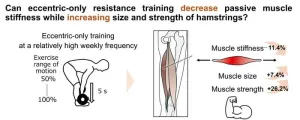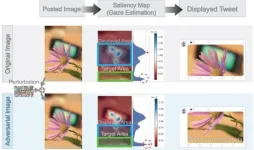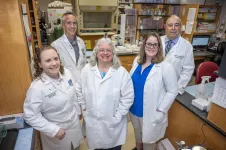(Press-News.org) Higher levels of urinary metals such as cadmium, tungsten, uranium, cobalt, copper and zinc are linked to increased cardiovascular disease and mortality in a racially and ethnically diverse U.S. population, according to a new study at Columbia University Mailman School of Public Health. While it is well documented that exposure to certain metals has been associated with cardiovascular disease (CVD) and mortality, until now the evidence was limited beyond arsenic, cadmium, and lead and for a racially diverse population. The findings are published in the journal Circulation.
When analyzed together, the 6 metal-mixture including cadmium, tungsten, uranium, copper, cobalt, and zinc was associated with a 29 percent increased risk of cardiovascular disease and a 66% increased risk of death over the study follow up of 18 years. Increased risk of CVD and mortality was also identified for every metal individually.
“Our study presents the results from the largest prospective study of urinary metals and cardiovascular disease to date and supports the role of urinary metals as novel risk factors for CVD and all-cause mortality risk,” said Irene Martinez-Morata, MD, PhD, in the Department of Environmental Health Sciences at Columbia Mailman School, and lead author. “Our findings can inform risk prediction and preventive strategies to improve cardiovascular health by reducing metal exposures across diverse populations.”
Exposure to metals is widespread, The sources and routes of exposure vary, and can be exacerbated by climate change leading to the contamination of air, soil and water, and ultimately the food chain. Higher burden of metal exposures has been documented across population groups such as non-Hispanic Black, Hispanic/Latino, Chinese, and American Indians, and among communities with lower socioeconomic status, revealing that sociopolitical, historical and structural factors, contribute to disparities beyond individual-level factors such as smoking, occupation and diet. “Interventions to reduce metal exposure can particularly benefit these population groups who also suffer a higher burden of CVD mortality” adds Irene Martinez-Morata.
The American Heart Association recently recognized the toxic metals arsenic, cadmium, and lead as associated with some incidence of CVD. However, until now, studies assessing the effects of less studied metals, including biometals such as copper and zinc, and metal mixtures, more likely to mimic real life exposures, have been limited.
Using the Multi-Ethnic Study of Atherosclerosis (MESA), the researchers assessed the association of six urinary metals with CVD events and mortality from six urban and suburban U.S. communities: Baltimore City and Baltimore County, Maryland; Chicago; Forsyth County, North Carolina; Los Angeles County; Northern Manhattan and the Bronx, NYC; and St. Paul, Minnesota, in July 2000-August 2002. Urine samples were analyzed at the Trace Metals Core Laboratory at Columbia University. To assess the joint effect of urinary metals as a mixture the researchers conducted additional analyses using a machine learning approach recently developed at the Department of Biostatistics at Columbia University.
Of the population analyzed, 39 percent were non-Hispanic White, 27 percent non-Hispanic Black, 22 percent Hispanic/Latino, and 12 percent Chinese descent. Over the study follow up period, 1,162 participants developed CVD and 1,844 participants died.
After accounting for established risk factors of CVD like smoking, hypertension or diabetes, the study identified that higher levels of the mixture of cadmium, tungsten, uranium, cobalt, copper, and zinc in the urine were associated with a 29 percent and a 66 percent increased risk of CVD and mortality, respectively, over the study follow up. For individual metals, higher levels of cadmium were associated with up to 25 percent and 68 percent higher risk of CVD and mortality, respectively. Similar associations were identified for all the other metals.
“Exposure to less studied metals such as tungsten and uranium is common in the U.S. and can occur through drinking water, food, air pollution, and indoor dust,” observed Martinez. While some metals, known as biometals, like copper and zinc are needed in little amounts by our body, high levels of these metals in the urine can be harmful. “While this is an ongoing field of study, high levels of essential metals in the urine can indicate an excess in exposure or loss of body reserves of these nutrients, which can occur when the metabolism is starting to malfunction, as it occurs in early stages of cardiovascular disease.”
“Implementing policies and regulations for air pollution, drinking water and food contamination, and consumer products at the federal level, in addition to addressing community and household vulnerability factors, and individual behavioral changes can reduce exposure to metals, and we note that further analyses will help inform prevention strategies and interventions, including those directed at less studied and unregulated metals such as tungsten or cobalt” noted Martinez. “And while federal regulations for lowering maximum contaminant levels for drinking water and banning leaded gasoline, for example, have successfully reduced exposure to toxic metals such as arsenic, cadmium, and lead in water and air, much more study is needed to understand the contributions of such metals as tungsten and cobalt.”
“A strength of our study is how we assessed the association of urine metals as a mixture,” said Ana Navas-Acien, MD, PhD, professor and chair of Columbia Mailman School Department of Environmental Health Sciences. “In addition to sampling a large population size and a racially and diverse participant base, we used state-of-the-art laboratory methods – led by our Trace Metals Core Laboratory, and we analyzed outcomes over a long follow-up. However, future studies using repeated measures of urine metal levels can provide even more advanced information about exposure over time.”
“The findings underscore the importance of reducing environmental exposure to these metals, which have disproportionately affected minority and poorer communities,” says Cashell Jaquish, PhD, a genetic epidemiologist at the National Heart, Lung, and Blood Institute (NHLBI), part of the National Institutes of Health (NIH), and a program officer with the MESA study. “The results could lead to efforts to reduce metal exposure in our communities and thereby reduce health disparities in heart disease, the leading cause of death in this country.”
Co-authors are Kathrin Schilling, Ronald Glabonjat,, Arce Domingo-Relloso, Melanie Mayer, Marta Galvez Fernandez, Tiffany Sanchez, Linda Valeri, and Anne Nigra, Columbia Mailman School of Public Health; Joel Kaufman, University of Washington; Dhananjay Vaidya and Wendy Post, Johns Hopkins University; Miranda Jones, Johns Hopkins Bloomberg School of Public Health; Michael Bancks, Wake Forest University School of Medicine; R.Graham Barr, Daichi Shimbo and Steven Shea, Columbia University Irving Medical Center.
The Multi-Ethnic Study of Atherosclerosis (MESA) is supported by the National Heart, Lung, and Blood Institute, grants 75N92020D00001, HHSN268201500003I, N01-HC-95159, 75N92020D00005, N01-HC-95160, 75N92020D00002, N01-HC-95161, 75N92020D00003, N01-HC-95162, 75N92020D00006, N01-HC-95163, 75N92020D00004, N01-HC-95164, 75N92020D00007, N01-HC-95165, N01-HC-95166, N01-HC-95167, N01-HC-95168 and N01-HC-95169. Please see the paper for a complete list of the organizations supporting the research.
The authors report no conflicts of interest.
DISCLAIMER: The content is solely the responsibility of the authors and does not necessarily represent the official views of the National Institutes of Health.
Columbia University Mailman School of Public Health
Founded in 1922, the Columbia University Mailman School of Public Health pursues an agenda of research, education, and service to address the critical and complex public health issues affecting New Yorkers, the nation and the world. The Columbia Mailman School is the fourth largest recipient of NIH grants among schools of public health. Its nearly 300 multi-disciplinary faculty members work in more than 100 countries around the world, addressing such issues as preventing infectious and chronic diseases, environmental health, maternal and child health, health policy, climate change and health, and public health preparedness. It is a leader in public health education with more than 1,300 graduate students from 55 nations pursuing a variety of master’s and doctoral degree programs. The Columbia Mailman School is also home to numerous world-renowned research centers, including ICAP and the Center for Infection and Immunity. For more information, please visit www.mailman.columbia.edu.
END
Largest study to date finds multiple urinary metals play key role in cardiovascular disease and mortality
2024-08-01
ELSE PRESS RELEASES FROM THIS DATE:
Tipping risks from overshooting 1.5 °C can be minimised if warming is swiftly reversed
2024-08-01
Human-made climate change can lead to a destabilisation of large-scale components of the Earth system such as ice sheets or ocean circulation patterns, the so-called tipping elements. While these components will not tip over night, fundamental processes are put into motion unfolding over tens, hundreds or thousands of years. These changes are of such a serious nature that they should be avoided at all costs, the researchers argue. In their new study, they assessed the risks of destabilisation of at least one ...
Which strains of tuberculosis are the most infectious?
2024-08-01
For some forms of tuberculosis, the chances that an exposed person will get infected depend on whether the individual and the bacteria share a hometown, according to a new study comparing how different strains move through mixed populations in cosmopolitan cities.
Results of the research, led by Harvard Medical School scientists and published Aug. 1 in Nature Microbiology, provide the first hard evidence of long-standing observations that have led scientists to suspect that pathogen, place, and human host ...
New AI tool simplifies heart monitoring: Fewer leads, same accuracy
2024-08-01
LA JOLLA, CA—To diagnose heart conditions including heart attacks and heart rhythm disturbances, clinicians typically rely on 12-lead electrocardiograms (ECGs)—complex arrangements of electrodes and wires placed around the chest and limbs to detect the heart’s electrical activity. But these ECGs require specialized equipment and expertise, and not all clinics have the capability to perform them.
Now, a team of scientists and clinicians from Scripps Research has shown that heart conditions can be diagnosed roughly as accurately using just three electrodes and an artificial intelligence (AI) tool. In a ...
Tipping risks from overshooting 1.5°C can be minimized if warming is swiftly reversed
2024-08-01
Current climate policies imply a high risk for tipping of critical Earth system elements, even if temperatures return to below 1.5°C of global warming after a period of overshoot. A new study indicates that these risks can be minimized if warming is swiftly reversed.
Human-made climate change can lead to a destabilization of large-scale components of the Earth system such as ice sheets, ocean circulation patterns, or global biosphere components, the so-called tipping elements. In their new study published in Nature Communications, researchers from IIASA and the Potsdam Institute for Climate Impact Research (PIK) analyzed the risks for four interconnected core climate tipping elements ...
Comprehensive meta-analysis pinpoints what vaccination strategies different countries should adopt
2024-08-01
Vaccines are safe and effective, and help reduce death and illness. But global vaccination rates are suboptimal and have trended downward, leaving humanity more vulnerable to vaccine-preventable diseases such as COVID-19, influenza, measles, polio, and HPV.
Identifying interventions that could increase vaccine coverage could help save lives. A new paper from a team led by researchers at the University of Pennsylvania offers the first comprehensive meta-analysis examining what types of vaccine intervention strategies have the ...
Predicting the future: Easy tool helps estimate fall risks
2024-08-01
Osaka, Japan — An aging society has posed a new global problem, the risk of falling. It is estimated that 1 in 3 adults over the age of 65 falls each year and the resulting injuries are becoming more prevalent.
To tackle this growing issue, Associate Professor Hiromitsu Toyoda and Specially Appointed Professor Tadashi Okano from Osaka Metropolitan University’s Graduate School of Medicine, together with Professor Chisato Hayashi from the University of Hyogo, have developed a formula and assessment tool for estimating fall risks that is simple for older adults to use. The tool was developed using data collected from older adults over a ten-year period from April 2010 to December ...
Eccentric-only resistance training can lower passive muscle stiffness
2024-08-01
Resistance, or weight training, is widely recommended in sports and rehabilitation as an effective exercise to increase muscular strength and size. This form of exercise involves applying resistance to muscle contraction to build strength. However, some practitioners believe resistance training can increase passive muscle stiffness over time. Passive muscle stiffness is a key indicator of how muscles behave mechanically when they are stretched without active contraction. Specifically, it refers to the amount of force required to change the muscle length by a given amount during passive stretching. Studies ...
Enhancing automatic image cropping models with advanced adversarial techniques
2024-08-01
Image cropping is an essential task in many contexts, right from social media and e-commerce to advanced computer vision applications. Cropping helps maintain image quality by avoiding unnecessary resizing, which can degrade the image and consume computational resources. It is also useful when an image needs to conform to a predetermined aspect ratio, such as in thumbnails. Over the past decade, engineers around the world have developed various machine learning (ML) models to automatically crop images. These models aim to crop an input image in a way that preserves its most relevant parts.
However, ...
$2.4 million grant helping MCG scientists better understand what happens to our skeleton as we age
2024-08-01
AUGUSTA, Ga. (Aug. 1, 2024) – Figuring out how the tissues in our bones, adrenal glands, muscle and fat “talk” to each other could help scientists better understand what happens to our skeletons with age, when our bones tend to lose mass and become weaker, leaving us at risk for falls and fractures.
“Tissues don’t function in isolation – everything in the body “talks” to everything else to keep people healthy across the lifespan,” explains Meghan McGee-Lawrence, PhD, bone biologist at the Medical College of Georgia at ...
Using AI, USC researchers pioneer a potential new immunotherapy approach for treating glioblastoma
2024-08-01
In an innovative new study of glioblastoma, scientists used artificial intelligence (AI) to reprogram cancer cells, converting them into dendritic cells (DCs), which can identify cancer cells and direct other immune cells to kill them.
Glioblastoma is the most common brain cancer in adults and also the deadliest, with less than 10% of patients surviving five years after their diagnosis. While new approaches such as immunotherapy have revolutionized treatment for other cancers, they have done little for patients with glioblastoma. That is partly because these hard-to-reach brain tumors ...




